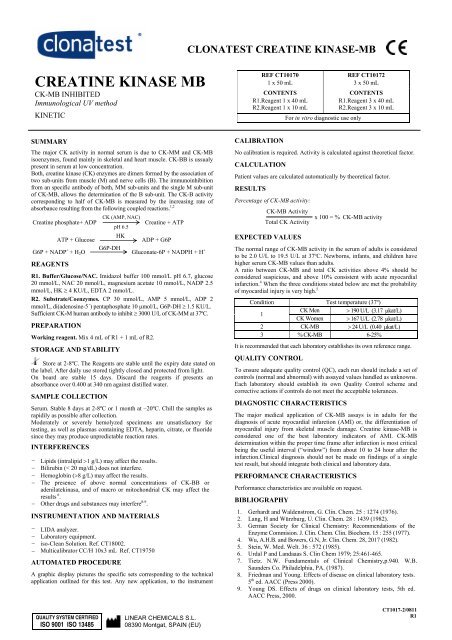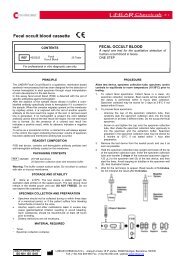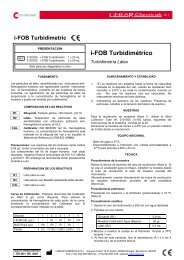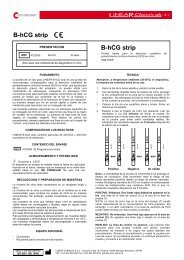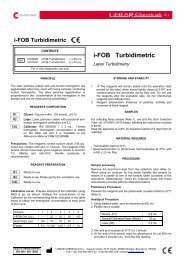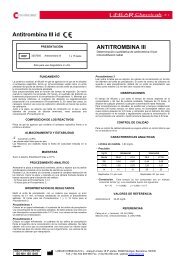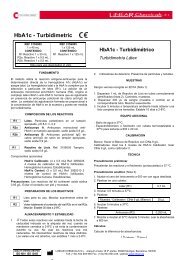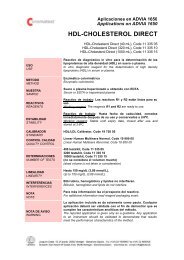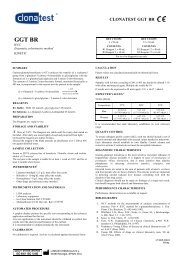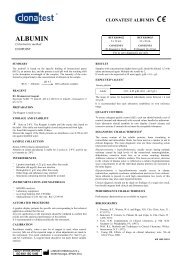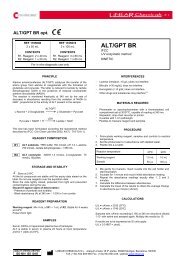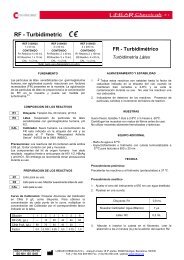CREATINE KINASE MB - LINEAR CHEMICALS
CREATINE KINASE MB - LINEAR CHEMICALS
CREATINE KINASE MB - LINEAR CHEMICALS
You also want an ePaper? Increase the reach of your titles
YUMPU automatically turns print PDFs into web optimized ePapers that Google loves.
CLONATEST <strong>CREATINE</strong> <strong>KINASE</strong>-<strong>MB</strong><br />
<strong>CREATINE</strong> <strong>KINASE</strong> <strong>MB</strong><br />
CK-<strong>MB</strong> INHIBITED<br />
Immunological UV method<br />
KINETIC<br />
REF CT10170<br />
REF CT10172<br />
1 x 50 mL 3 x 50 mL<br />
CONTENTS<br />
CONTENTS<br />
R1.Reagent 1 x 40 mL<br />
R1.Reagent 3 x 40 mL<br />
R2.Reagent 1 x 10 mL<br />
R2.Reagent 3 x 10 mL<br />
For in vitro diagnostic use only<br />
SUMMARY<br />
The major CK activity in normal serum is due to CK-MM and CK-<strong>MB</strong><br />
isoenzymes, found mainly in skeletal and heart muscle. CK-BB is ussualy<br />
present in serum at low concentration.<br />
Both, creatine kinase (CK) enzymes are dimers formed by the association of<br />
two sub-units from muscle (M) and nerve cells (B). The immunoinhibition<br />
from an specific antibody of both, MM sub-units and the single M sub-unit<br />
of CK-<strong>MB</strong>, allows the determination of the B sub-unit. The CK-B activity<br />
corresponding to half of CK-<strong>MB</strong> is measured by the increasing rate of<br />
absorbance resulting from the following coupled reactions. 1,2<br />
CK (AMP, NAC)<br />
Creatine phosphate+ ADP<br />
Creatine + ATP<br />
pH 6.5<br />
HK<br />
ATP + Glucose<br />
ADP + G6P<br />
G6P + NADP + G6P-DH<br />
+ H 2 O Gluconate-6P + NADPH + H +<br />
REAGENTS<br />
R1. Buffer/Glucose/NAC. Imidazol buffer 100 mmol/L pH 6.7, glucose<br />
20 mmol/L, NAC 20 mmol/L, magnesium acetate 10 mmol/L, NADP 2.5<br />
mmol/L, HK ≥ 4 KU/L, EDTA 2 mmol/L.<br />
R2. Substrate/Coenzymes. CP 30 mmol/L, AMP 5 mmol/L, ADP 2<br />
mmol/L, di(adenosine-5´) pentaphosphate 10 μmol/L, G6P-DH ≥ 1.5 KU/L.<br />
Sufficient CK-M human antibody to inhibit ≥ 3000 U/L of CK-MM at 37ºC.<br />
PREPARATION<br />
Working reagent. Mix 4 mL of R1 + 1 mL of R2.<br />
STORAGE AND STABILITY<br />
Store at 2-8ºC. The Reagents are stable until the expiry date stated on<br />
the label. After daily use stored tightly closed and protected from light.<br />
On board are stable 15 days. Discard the reagents if presents an<br />
absorbance over 0.400 at 340 nm against distilled water.<br />
SAMPLE COLLECTION<br />
Serum. Stable 8 days at 2-8ºC or 1 month at –20ºC. Chill the samples as<br />
rapidily as possible after collection.<br />
Moderately or severely hemolyzed specimens are unsatisfactory for<br />
testing, as well as plasmas containing EDTA, heparin, citrate, or fluoride<br />
since they may produce unpredictable reaction rates.<br />
INTERFERENCES<br />
−<br />
−<br />
−<br />
−<br />
−<br />
Lipids (intralipid >1 g/L) may affect the results.<br />
Bilirubin (< 20 mg/dL) does not interfere.<br />
Hemoglobin (>8 g/L) may affect the results.<br />
The presence of above normal concentrations of CK-BB or<br />
adenilatekinasa, and of macro or mitochondrial CK may affect the<br />
results 6 .<br />
Other drugs and substances may interfere 8-9 .<br />
INSTRUMENTATION AND MATERIALS<br />
−<br />
−<br />
−<br />
−<br />
LIDA analyzer.<br />
Laboratory equipment.<br />
iso-Clean Solution. Ref. CT18002.<br />
Multicalibrator CC/H 10x3 mL Ref. CT19750<br />
AUTOMATED PROCEDURE<br />
A graphic display pictures the specific sets corresponding to the technical<br />
application outlined for this test. Any new application, to the instrument<br />
CALIBRATION<br />
No calibration is required. Activity is calculated against theoretical factor.<br />
CALCULATION<br />
Patient values are calculated automatically by theoretical factor.<br />
RESULTS<br />
Percentage of CK-<strong>MB</strong> activity:<br />
EXPECTED VALUES<br />
The normal range of CK-<strong>MB</strong> activity in the serum of adults is considered<br />
to be 2.0 U/L to 19.5 U/L at 37ºC. Newborns, infants, and children have<br />
higher serum CK-<strong>MB</strong> values than adults.<br />
A ratio between CK-<strong>MB</strong> and total CK activities above 4% should be<br />
considered suspicious, and above 10% consistent with acute myocardial<br />
infarction. 4 When the three conditions stated below are met the probability<br />
of myocardial injury is very high. 5<br />
Condition Test temperature (37º)<br />
1<br />
CK Men > 190 U/L (3.17 μkat/L)<br />
CK Women > 167 U/L (2.78 μkat/L)<br />
2 CK-<strong>MB</strong> > 24 U/L (0.40 μkat/L)<br />
3 % CK-<strong>MB</strong> 6-25%<br />
It is recommended that each laboratory establishes its own reference range.<br />
QUALITY CONTROL<br />
To ensure adequate quality control (QC), each run should include a set of<br />
controls (normal and abnormal) with assayed values handled as unknowns.<br />
Each laboratory should establish its own Quality Control scheme and<br />
corrective actions if controls do not meet the acceptable tolerances.<br />
DIAGNOSTIC CHARACTERISTICS<br />
The major medical application of CK-<strong>MB</strong> assays is in adults for the<br />
diagnosis of acute myocardial infarction (AMI) or, the differentiation of<br />
myocardial injury from skeletal muscle damage. Creatine kinase-<strong>MB</strong> is<br />
considered one of the best laboratory indicators of AMI. CK-<strong>MB</strong><br />
determination within the proper time frame after infarction is most critical<br />
being the useful interval (“window”) from about 10 to 24 hour after the<br />
infarction.Clinical diagnosis should not be made on findings of a single<br />
test result, but should integrate both clinical and laboratory data.<br />
PERFORMANCE CHARACTERISTICS<br />
Performance characteristics are available on request.<br />
BIBLIOGRAPHY<br />
1.<br />
2.<br />
3.<br />
4.<br />
5.<br />
6.<br />
7.<br />
8.<br />
9.<br />
CK-<strong>MB</strong> Activity<br />
x 100 = % CK-<strong>MB</strong> activity<br />
Total CK Activity<br />
Gerhardt and Waldenstrom, G. Clin. Chem. 25 : 1274 (1976).<br />
Lang, H and Würzburg, U. Clin. Chem. 28 : 1439 (1982).<br />
German Society for Clinical Chemistry: Recommendations of the<br />
Enzyme Commision. J. Clin. Chem. Clin. Biochem. 15 : 255 (1977).<br />
Wu, A.H.B. and Bowers, G.N, Jr. Clin. Chem. 28, 2017 (1982).<br />
Stein, W. Med. Welt. 36 : 572 (1985).<br />
Urdal P and Landaaas S. Clin Chem 1979; 25:461-465.<br />
Tietz. N.W. Fundamentals of Clinical Chemistry,p.940. W.B.<br />
Saunders Co. Philadelphia, PA. (1987).<br />
Friedman and Young. Effects of disease on clinical laboratory tests.<br />
5 th ed. AACC (Press 2000).<br />
Young DS. Effects of drugs on clinical laboratory tests, 5th ed.<br />
AACC Press, 2000.<br />
QUALITY SYSTEM CERTIFIED<br />
ISO 9001 ISO 13485<br />
<strong>LINEAR</strong> <strong>CHEMICALS</strong> S.L.<br />
08390 Montgat, SPAIN (EU)<br />
CT1017-2/0811<br />
R1
CLONATEST <strong>CREATINE</strong> <strong>KINASE</strong>-<strong>MB</strong><br />
CREATINA QUINASA <strong>MB</strong><br />
CK-<strong>MB</strong> INHIBIDA<br />
Método inmunológico UV<br />
CINETICO<br />
REF CT10170<br />
REF CT10172<br />
1 x 50 mL 3 x 50 mL<br />
CONTENIDO<br />
CONTENIDO<br />
R1.Reactivo 1 x 40 mL R1.Reactivo 3 x 40 mL<br />
R2.Reactivo 1 x 10 mL R2.Reactivo 3 x 10 mL<br />
Sólo para uso diagnóstico in vitro<br />
FUNDAMENTO<br />
La mayor actividad de la CK en sueros normales se debe a los isoenzimas<br />
CK-MM y CK-<strong>MB</strong> presentes en los tejidos muscular y cardiaco. La CK-BB<br />
se halla presente a muy bajas concentraciones. Ambos enzimas de la (CK)<br />
son dímeros formados por la asociación de dos subunidades de músculo<br />
(M) y células nerviosas (B). La immunoinhibición mediante un anticuerpo<br />
específico de ambas subunidades MM y la unidad individual de la CK-<br />
<strong>MB</strong> permite la determinación de la subunidad B. La actividad<br />
correspondiente a la mitad de la CK-<strong>MB</strong> se mide a través del aumento de<br />
la absorbancia resultante de las siguientes reacciones acopladas. 1,2<br />
CK (AMP, NAC)<br />
Creatina fosfato+ ADP<br />
Creatina + ATP<br />
pH 6,5<br />
HK<br />
ATP + Glucosa<br />
ADP + G6P<br />
G6P + NADP + G6P-DH<br />
+ H 2 O Gluconato-6P + NADPH + H +<br />
REACTIVOS<br />
R1. Tampón/Glucosa/NAC. Tampón imidazol 100 mmol/L pH 6,7,<br />
glucosa 20 mmol/L, NAC 20 mmol/L, acetato de magnesio 10 mmol/L,<br />
NADP 2,5 mmol/L, HK ≥ 4 KU/L, EDTA 2 mmol/L.<br />
R2. Sustrato/Coenzimas. CP 30 mmol/L, AMP 5 mmol/L, ADP 2 mmol/L,<br />
di(adenosina-5´) pentafosfato 10 μmol/L, G6P-DH ≥ 1,5 KU/L.<br />
CK-M humano suficiente para inhibir ≥ 3000 U/L de CK-MM a 37ºC.<br />
PREPARACION<br />
Reactivo de trabajo. Mezclar 4 mL de R1 + 1 mL de R2.<br />
ALMACENAMIENTO Y ESTABILIDAD<br />
Conservar a 2-8ºC. Los reactivos son estables hasta la fecha de caducidad<br />
indicada en la etiqueta. Después de su uso , mantener cerrado y protegido de<br />
la luz. En el analizador son estables 15 días. Desechar el reactivo si presenta<br />
una absorbancia superior a 0,400 a 340 nm frente agua destilada.<br />
MUESTRAS<br />
Suero. Estable 8 días a 2-8ºC ó 1 mes a –20ºC. Enfriar las muestras a la<br />
mayor brevedad posible tras su obtención.<br />
Muestras hemolizadas así como plasmas conteniendo EDTA, heparina,<br />
citrato o fluoruro ocasionan velocidades de reacción erráticas.<br />
INTERFERENCIAS<br />
−<br />
−<br />
−<br />
−<br />
−<br />
Lipemia (intralipid >1 g/L) puede afectar los resultados.<br />
Bilirrubina (< 20 mg/dL) no interfiere.<br />
Hemoglobina (>8 g/L) puede afectar los resultados.<br />
La presencia de concentraciones superiores a lo normal de CK-BB o<br />
de adenilato quinasa y de macro-CK o CK mitocondrial puede<br />
afectar los resultados 6 .<br />
Otros medicamentos y sustancias pueden interferir 8-9 .<br />
EQUIPO ADICIONAL<br />
−<br />
−<br />
−<br />
−<br />
Analizador LIDA.<br />
Material de laboratorio.<br />
iso-Clean Solution. Ref. CT18002.<br />
Multicalibrator CC/H 10x3 mL Ref. CT19750<br />
TECNICA AUTOMATICA<br />
Una representación grafica visualiza los ajustes específicos<br />
correspondientes a la aplicación técnica diseñada para este ensayo.<br />
Cualquier aplicación nueva al instrumento deberá validarse para<br />
confirmar que los resultados cumplen las características del método.<br />
Se recomienda validar periódicamente el instrumento.<br />
CALIBRACION<br />
No precisa calibración. La actividad se calcula aplicando un factor teórico.<br />
CALCULOS<br />
El valor de las muestras se calcula automáticamente con el factor teórico.<br />
RESULTADOS<br />
Porcentaje de la actividad CK-<strong>MB</strong><br />
Actividad CK-<strong>MB</strong><br />
x 100 = % Actividad CK-<strong>MB</strong><br />
Actividad CK total<br />
VALORES DE REFERENCIA<br />
El rango de normalidad de la actividad CK-<strong>MB</strong> en suero de adultos se<br />
situa entre las 2,0 U/L y 19,5 U/L a 37ºC. Los recien nacidos, niños y<br />
jóvenes presentan valores de CK-<strong>MB</strong> en suero más altos que los adultos.<br />
El porcentaje de actividad CK-<strong>MB</strong> por encima del 4% debe considerarse<br />
sospechoso y por encima del 10% relacionado con el infarto de miocardio<br />
agudo. 4 Cuando las tres condiciones consignadas a continuación se cumplen,<br />
la probabilidad de lesión miocárdica es muy alta. 5<br />
Condición Temperatura del ensayo (37º)<br />
1<br />
CK Hombres > 190 U/L (3,17 μkat/L)<br />
CK Mujeres > 167 U/L (2,78 μkat/L)<br />
2 CK-<strong>MB</strong> > 24 U/L (0,40 μkat/L)<br />
3 % CK-<strong>MB</strong> 6-25%<br />
Se recomienda que cada laboratorio establezca su propio rango de referencia.<br />
CONTROL DE CALIDAD<br />
Para un control de calidad (CC) adecuado, se incluirán en cada serie<br />
controles valorados (normal y abnormal) que se tratarán como muestras<br />
problema. Cada laboratorio debe establecer su propio Control de Calidad y<br />
sus medidas correctoras cuando los controles no cumplan con las<br />
tolerancias exigidas.<br />
SIGNIFICADO CLINICO<br />
La mayor aplicación médica de los ensayos de CK-<strong>MB</strong> se halla en el<br />
diagnóstico del infarto agudo de miocardio en adultos y en la<br />
diferenciación entre la lesión cardíaca y la del músculo esquelético. La<br />
creatina quinasa-<strong>MB</strong> es considerada una de las mejores pruebas de<br />
laboratorio para este fin. La determinación dentro del marco de tiempo<br />
adecuado tras el infarto es la más crítica, siendo el intervalo más útil el<br />
comprendido entre las 10 y las 24 horas del ataque.<br />
CARACTERISTICAS ANALITICAS<br />
Las características analíticas están disponibles bajo solicitud.<br />
REFERENCIAS<br />
1.<br />
2.<br />
3.<br />
4.<br />
5.<br />
6.<br />
7.<br />
8.<br />
9.<br />
Gerhardt y Waldenstrom, G. Clin. Chem. 25 : 1274 (1976).<br />
Lang, H y Würzburg, U. Clin. Chem. 28 : 1439 (1982).<br />
German Society for Clinical Chemistry: Recommendations of the<br />
Enzyme Commision. J. Clin. Chem. Clin. Biochem. 15 : 255 (1977).<br />
Wu, A.H.B. y Bowers, G.N, Jr. Clin. Chem. 28, 2017 (1982).<br />
Stein, W. Med. Welt. 36 : 572 (1985).<br />
Urdal P y Landaaas S. Clin Chem 1979; 25:461-465.<br />
Tietz. N.W. Fundamentals of Clinical Chemistry,p.940. W.B.<br />
Saunders Co. Philadelphia, PA. (1987).<br />
Friedman y Young. Effects of disease on clinical laboratory tests. 5 th<br />
ed. AACC (Press 2000).<br />
Young DS. Effects of drugs on clinical laboratory tests, 5th ed.<br />
AACC Press, 2000.<br />
QUALITY SYSTEM CERTIFIED<br />
ISO 9001 ISO 13485<br />
<strong>LINEAR</strong> <strong>CHEMICALS</strong> S.L.<br />
08390 Montgat, SPAIN (EU)


